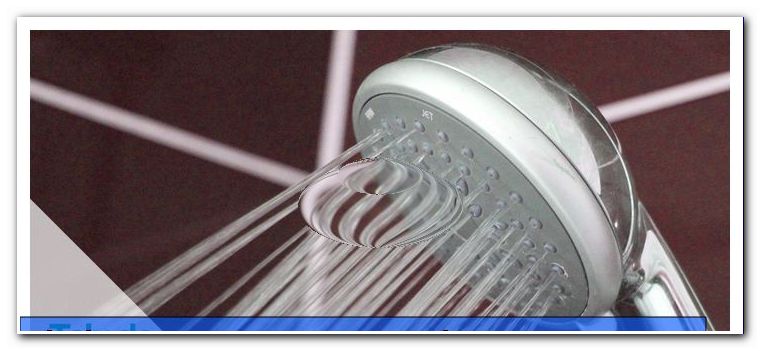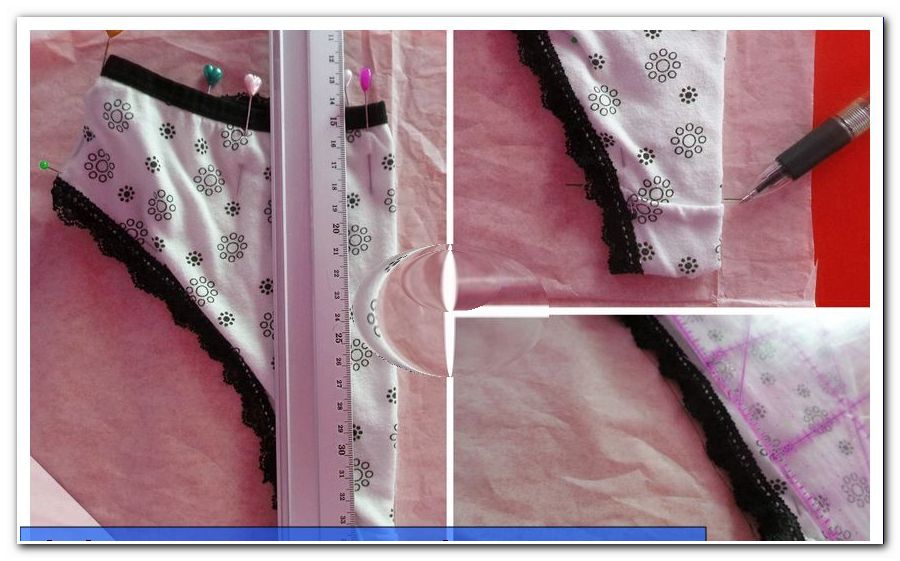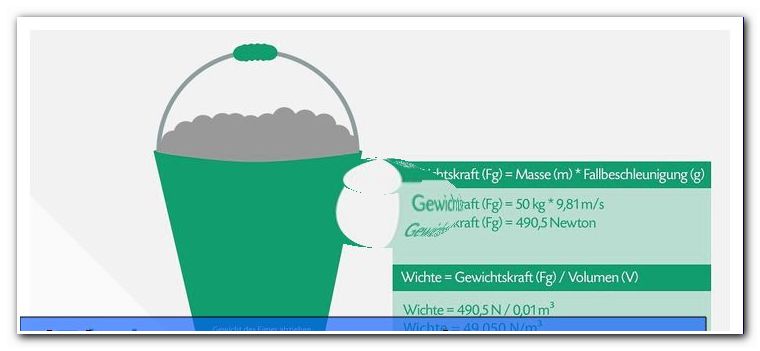Ebony - Information on color, properties and prices

- Black ebony
- Woods from Africa
- Woods from Asia
- Woods from America
- Color striped ebony
- characteristics
- desiccation
- resistance
- use
- processing
- Prices
- False ebony
Black and shiny - these are the most famous properties of ebony. Ebony - known primarily as tropical wood - is not the same as ebony. In addition to the so-called black ebony, there are also color-striped varieties whose lighter primary colors in combination with dark stripes make each piece unique. Read in this text everything you need to know about ebony.
Ebony grows exclusively in tropical and subtropical forests. Ebony is not growing in Europe. The black wood is considered in this country for centuries as noble and precious. So it was used in the 16th and 17th centuries in Europe for the production of fine furniture. Ebony furniture was the hippest piece of furniture of all time. Due to massive deforestation of rare trees despite high sapwood for centuries, today almost all ebony species are protected. They are considered endangered species and are therefore available in this country only in small quantities on the market. This is one of the reasons for the high price of tropical wood, one of the hardest in the world.
Ebony belongs to the genus "Diospyros" . Most members of the genus, which includes several hundred species, are pink-gray woods. Only a few have black or striped heartwoods.
These rare species are now grouped in the group of ebony trees. The name of each variety usually refers to the origin of the wood. Some varieties are offered under their name and / or their regional name. All ebony come from tropical countries, but where they also appear scattered. Therefore, impact as well as export are exactly regulated.

"Her hair is black as ebony." This description of the hair of Snow White in the fairy tale of the Brothers Grimm has shaped the idea of ebony in this country for centuries. But ebony is not always deep black, depending on the variety, color and appearance of the tropical exotic wood vary. Basically, a distinction is made between black and colored ebony.
Ebony is obtained from small to medium-sized trees. The usable part of the trunks is, depending on the type, between 3 and 18 meters. Its diameter is 60 to 90 centimeters. In black ebony, the maximum length of the usable strain is often only four meters and the diameter at just 40 centimeters.
Black ebony
Black ebony woods are the most valuable and at the same time rarest woods. Their sapwood is between six and eight centimeters wide. Its color is white to pink gray. The black heartwood sometimes has a deep blue-black tint. It may also have partly irregular and blurred brownish or black-gray fields.
The trees grow in tropical and subtropical forests. The main producing countries are Africa (Gabon, Cameroon, Madagascar, Nigeria and Zaire), Asia (India, Papua New Guinea and Sri Lanka) and America (Cuba and Mexico). Trade names for the noble, black woods are among others:
Woods from Africa
- Cameroon Ebony:
This ebony is open-pored. It is deep black and has mostly gray veins. In the world market, this ebony is the most traded. However, its porosity makes it less valued than fine-pored varieties.
- African ebony
- Gabon ebony
- Madagascar Ebony:
A very dark, brown wood characterizes this fine-pored ebony species.
- Nigeria ebony
- bingo
- Evila
- Ebano, Ebony and Ebéne:
All three terms do not refer to special varieties of black ebony. "Ebano" is the Italian, "Ebony" the English and "Ebéne" the French name for ebony.
Woods from Asia
- Ceylon ebony:
Ebony from Ceylon, also called "Black Ebony", is the most valuable type of ebony. It has the best quality, but is extremely rare and rarely, if at all, commercially available in small quantities. His pores are virtually imperceptible.
- Indian ebony
- Papua ebony
- Solomon Islands Ebony
- Makleua
- Mun
Woods from America
- Cuban ebony
- Mexican ebony
- Ebano real
- Zapote negro
Color striped ebony
For streaky ebony, the basic color and the density and width of the stripes vary, depending on the species. Their gray or pale pink to brownish sapwood is a few inches wide. For some varieties, the sapwood can account for up to 70 percent. Their heartwood is dark to reddish brown. Dark brown to black zones interrupt the heartwood, creating the distinctive stripes. The tangential cut creates colored "flowers" or "clouds".

Color striped or striped ebony grows like black wood in tropical and subtropical forests. The main producing countries are in Asia (Andaman, India, Sulawesi Indonesia and Philippines). Trade names for striped woods include:
- Andaman Marblewood:
This species comes from India and is often used in English for striped ebony.
- Makassar Ebony, also called Coromandel:
Often originating from Indonesia Makassar is offered and used in Germany most often. It has a middle brown ground tone in the heartwood, which is covered with different light and dark stripes. The color of the stripes ranges from reddish-light brown to black. Since the fiber growth can vary greatly, the most varied textures arise, but they are all very fine and slightly wavy. Massacre ebony has a slightly metallic sheen. The pore is fine to medium in size.

- Philippines ebony
- Bolong Eta:
In this wood, the dark rings can often outweigh or run together. This creates the impression of a striking black core.
- kamagong:
The Kamagong Ebony is also called Asian Ebony or Malaysian Ebony. The heartwood has a brown to violet-black color. It looks a lot like Makassar.
characteristics
Ebony is very heavy and extremely hard. It is one of the hardest woods in the world. The concrete properties of the wood differ depending on the type.
The mean values for black ebony are:
- Weight / undried logs: approx. 1.2 kg / cm3 - 1.4 kg / cm3
- Weight / dry: approx. 0.9 g / cm3 - 1.2 g / mm2
- Compressive strength: approx. 60 N / mm2 - 70 N / mm2
- Bending strength: 1, 000 kp / mm2 - 120 N / mm2
The measurements for Makassar ebony are:
- Bulk density: 1.0 - 1.03 g / cc
- Average volume density: approx. 1, 000 kg / m3
- Compressive strength: approx. 79 N / square millimeter
- Flexural strength: 190 N / square millimeter
wood structure
The pores of the ebony woods are scattered or fine to medium in size. Black ebony appears pore-free, as their pores are often filled with black . This also gives them their slightly metallic smoothness and corresponding shine. Since the wood rays are very fine, the wood image is not affected by them. Memory cells are recognizable in places only on smooth cross sections. They are then seen as extremely fine, tangential lines. The fibers run in striped woods in a slight alternating rotation. In places they are irregular in black species.
desiccation
Ebony needs to dry very slowly. If it is dried too quickly, especially in the phase of air-to-room drying, severe cracks can occur due to the high shrinkage values, the high density and the very slow internal drying. A special tendency to tearing is in Makassar. By contrast, black ebony tends to have smaller surface cracks. Also, the shrinkage is lower in these varieties.
resistance
Many ebony species are very weather and aging resistant. Also, the heartwoods are rarely attacked by insects or fungi. The Makassar Ebony is considered particularly resistant to aging.
use
Black ebony wood has been used in ancient Egypt to make artifacts. In the 16th and 17th centuries, furniture was made from black heartwood. Nowadays ebony wood is rarely used to produce furniture because of its high price. Thus, the wood is used mainly for veneers today. Further it is used for musical instruments, for example for piano keys, castanets, drumsticks, flutes, bassoons or clarinets. Furthermore, billiard cues, chess pieces or walking sticks as well as carved or turned objects are made from the black solid wood.
processing
Since ebony is much harder than any native wood, it should only be treated with very powerful tools. In addition, only undamaged pieces of wood should be processed - for the price alone. If there are cracks in the ebony, you should refrain from working because it usually does not lead to the desired result.
The so-called Pinholes are not regarded as wood defects. Pinholes are wormholes of the Ambrosia beetle. Since the Ambrosia lives only in the living or freshly felled tree, it is for dried wood no danger, because he has already left the felled tree. Nevertheless, the traces of the beetle leave a not to be underestimated disadvantage: The processing of the piece of wood can be made difficult by the Pinholes.

For all ebony species, the incision requires a lot of effort. Fits or preloads must be prepared very carefully. For turning and carving are basically all varieties well. Color-striped ebony woods are also easy to carve or plane. All types of ebony are glueable. The tropical wood can be polished very well to shine. For this very powerful tools must be used, otherwise the gloss will be ugly and greasy.
Black flat wood tends to break out at the ends. In thin rods, it usually comes to a smooth break. Basically, however, all ebony species have a tendency to splinter because of their hardness.
If the surface of an ebony is to be processed, trial strokes must be carried out. Depending on the nature of the product, discoloration or drying delays may occur. Since ebony has a very dense surface, there is less absorption than other woods. Therefore, the amount of the agent to be used should be set in advance. So "greasy" surfaces can be avoided.
If ebony is processed, good ventilation or extraction must be provided. But beware: The resulting dust causes skin and eye irritation and irritation of the lungs. Therefore, a protective mask or goggles should be worn during processing. If the sanding dust comes into contact with sweat, this too can quickly lead to irritation of the skin. Therefore, a corresponding protective clothing is necessary.
Prices
Many types of ebony are today among the protected woods. They are classified as endangered species. That's why ebony is only available in small quantities and at a high price. Therefore, the purchase should be paid close attention to the price.
For one cubic meter of Makassar sawn timber, between 19, 000 and 26, 000 euros must be expected in the timber trade. The prices for original cuts for particularly rare types of ebony start at 45, 000 euros per cubic meter.
In Germany, the price of ebony is often given in kilograms per cubic meter. Whether it is the offered ebony is now high or low quality wood, can be easily calculated. One cubic meter of good Makassar weighs between 900 and 1, 100 kilograms. If you take a cubic meter price of 20, 000 euros, one kilogram costs 18 to 22 euros . If the price is higher, it can certainly be a better quality.
Tip: Caution is advised when bargaining: At a significantly lower price may be inferior wood.
B-quality
Since ebony is only available in small quantities, the so-called B qualities are also offered. The prices for these woods can be up to 50 percent below those of the A-qualities. B qualities are less high quality and have some optical defects as well.
False ebony
False ebony is unfortunately widespread in this country. Although it corresponds visually to the real ebony, but can not compete in terms of hardness, durability and density. For the wrong ebony, stained native wood, usually pearwood or hornbeam wood, is used.
Tip: False ebony is not an invention of our time. Already in Schedel's "Waaren Lexikon" of 1814 is an entry on false ebony. On the Internet you will find numerous indications of today's cases of fraud.




